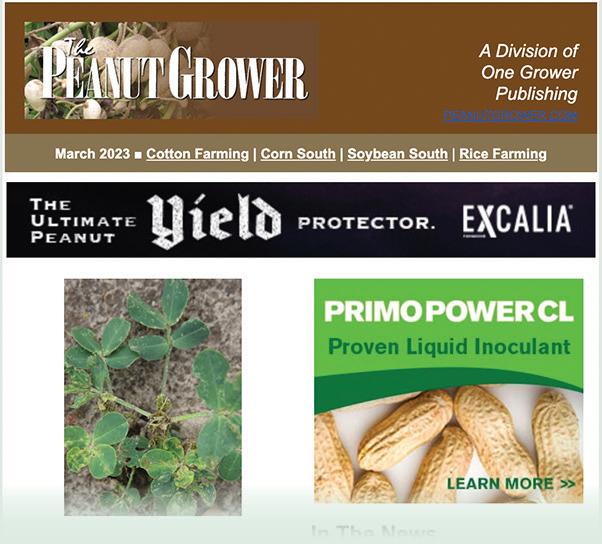














A Closer Look At Leaf Spot ONE GROWER PUBLISHING, LLC THE PEANUT PRODUCER'SMARKETING & PRODUCTION MAGAZINE www.peanutgrower.com PEANUT GROWER The MAY 2023 Planting Intentions Skippy Stand Q &A What Factors Dictate The First Spray?








10



Starting Leaf Spot Management








With Disease

14




16
Planting Intentions
Growers indicate their prospective crop mix for the 2023 season.
18

VT Team Earns Recognition For Drone Work
With efficient data collection, drones help advance peanut breeding.

MAY 2023 • THE PEANUT GROWER / 3 TWITTER: @PEANUTGROWER 10 4 Editor’s Note Researchers find NASS report mostly correct 5 News Briefs Ron Sholar retires from Oklahoma Peanut Commission 8 Market Watch Could EU purchases help firm up the market? Volume 35 • Number 5
A Closer Look At Leaf Spot ONE GROWER THE PEANUT PRODUCER'SMARKETING & PRODUCTION MAGAZINE www.peanutgrower.com PEANUT GROWER The MAY 2023 Planting Intentions Skippy Stand Q&A What Factors Dictate The First Spray? Features
Cover photo by Cale Cloud, Agricultural and Natural Resources Extension Agent, Grady County, Georgia
The first leaf spot fungicide application depends on several factors.
12 Difficulty
Watch for these fungal problems as the season progresses.
Skippy Stand Q & A
Timing, method and return on investment are some replanting questions.
Departments
Peanut Pointers
for a pattern in
MAY 2023
Sign up for the monthly e-newsletter at peanutgrower.com to have exclusive industry news and content delivered directly to your inbox. www.peanutgrower.com PeanutGrower @PeanutGrower @ThePeanutGrower
20
Look
stand gaps
Stay Connected
EDITORIAL/PRODUCTION
Editor Amanda Huber ahuber@onegrower.com
Copy Editor Cassidy Nemec cnemec@onegrower.com
Art Director Ashley Kumpe
Digital Content Manager Katie Guthrie
ADMINISTRATION
Publisher/Vice President
Lia Guthrie (901) 497-3689 lguthrie@onegrower.com
Associate Publisher/Editor-In-Chief


Carroll Smith (901) 326-4443
Associate Publisher/Sales Scott Emerson (386) 462-1532 semerson@onegrower.com
Audience Services
Kate Thomas (847) 559-7514
Production Manager David Boyd dboyd@onegrower.com
For subscription changes or change of address, call (847) 559-7578 or email peanutgrower@omeda.com
EDITORIAL ADVISORY BOARD
Scott Monfort
Extension Agronomist
University of Georgia
Dell Cotton
Peanut Growers Cooperative
Marketing Assn., Franklin, VA
Kris Balkcom
Agri-Program Associate
Auburn University
Dan Anco
Extension Peanut Specialist
Clemson University
Editor’s Note
Researchers Find NASS Report Mostly Correct
As usual in the May issue of Peanut Grower , this month includes the U.S. Department of Agriculture’s National Agricultural Statistics Service Prospective Plantings report issued March 31 of each year. The yearly numbers are based on a survey of producers prior to planting. Around the same time the report came out, I came across an article by Hunter Biram, University of Arkansas, and William Maples, Mississippi State University, on the reliability of the USDA NASS Prospective Plantings report. Interesting. I know USDA’s numbers are often questioned, but what did these researchers find?
Emi Kimura
Extension Agronomist
Texas A&M University
David Jordan
Extension Agronomist
North Carolina State University
Glen Harris
Extension Agronomist
University of Georgia
Jason Ferrell
Extension Weed Specialist University of Florida
ONE GROWER PUBLISHING, LLC
Mike Lamensdorf PRESIDENT/TREASURER Lia Guthrie PUBLISHER/VICE PRESIDENT
The Peanut Grower (ISSN 1042-9379) is an agribusiness magazine for U.S. peanut producers. Published in eight monthly issues, January through July and November. Annual subscriptions are $40.00. Single Copy price is $5.00. Annual overseas subscriptions are $70.00, including Canada/Mexico. Periodicals postage paid at at Memphis, Tennessee, and at additional mailing o ices. Copyright © 2023 One Grower Publishing, LLC, all rights reserved except where otherwise noted. The Peanut Grower ® is a registered trademark, which reserves all rights granted by the U.S. Patent and Trademark O ice in association with the registration.
POSTMASTER: SEND ADDRESS CHANGES TO OMEDA COMMUNICATIONS, CUSTOMER SERVICE DEPARTMENT, P.O. BOX 1388, NORTHBROOK, IL 60065-1388. All statements, including product claims, are those of the person or organization making the statement or claim. The publisher does not adopt any such statement or claim as its own, and any such statement or claim does not necessarily reflect the opinion of the publisher. Printed in the USA.
One Grower Publishing, LLC, also publishes Cotton Farming, Rice Farming, Soybean South and Corn South
One Grower Publishing, LLC 875 W. Poplar Ave., Suite 23, Box 305 Collierville, TN 38017
Amanda Huber Editor, e Peanut Grower

Not to give it all away, the researchers generally find the acreage projections to be mostly accurate where the only crops grown are corn and soybeans. Then there’s the South, where numbers tend to go askew, but mostly to a small degree say the economists. It almost made me chuckle thinking of why the numbers are off in my home region. Here are my ideas:
Thought #1: We don’t like to tell them our business anyway. This may stem from the old “I’m from the government, and I’m here to help” mentality. In other words, the less the government knows about your business, the better. But, as farmers, you are used to reporting acreage, signing up for programs and sharing this type information. So, I dismissed this thought.
Thought #2: No one wants to commit this far ahead to acreage specifics. This thought stems from a frequent notion in the Florida Keys or any other island or beach town where you are “living on island time.” Wonderful are those opportunities when you do not have to wear a watch or commit to being somewhere at a certain time. However, I dismissed this thought because most crops have an optimum planting window.
Thought #3: Everything is trying to kill your crop before it’s even planted. OK, this is an exaggeration. It is usually the weather keeping you from planting your preferred crop mix. Fortunately, in the South, there are alternative crops that can be planted if the optimum planting window of the first crop is missed because the weather is not cooperating with planting. There are alternatives because crop rotation is a must. The number of things trying to kill your crop after it is planted is not an exaggeration. Diseases, insects, weeds, drought, hail, hurricanes, the list goes on and on. Therefore, you must have a varied crop mix to keep any one of them yielding as needed. Was I close to what the researchers found with this final thought? You’ll have to turn to page 17 to find out.
4 / THE PEANUT GROWER • MAY 2023 PEANUTGROWER.COM
News Briefs
Industry Members Talk Farm Bill, Donate Peanut Butter
Representatives from the U.S. Peanut Federation recently traveled to Washington, D.C. for their annual spring fly-in. During the trip, USPF representatives met with key members of the U.S. House of Representatives and U.S. Senate, as well as senior agricultural staff, to discuss issues facing the peanut industry.
The USPF fly-in is essential to connect with Congress about peanut industry priorities, especially the Farm Bill, which is up for reauthorization in 2023. During their meetings, representatives discussed the rising costs of production for peanuts, the Price Loss Coverage program and the priorities for the 2023 Farm Bill.
The group also combined advocacy with service during the trip, donating more than 10,000 jars of peanut butter to the Capital Area Food Bank. USPF representatives were able to visit the food bank and hear firsthand how this donation will positively impact families in the local community.
Molly McGlinchy, deputy chief of programs and innovation at the Capital Area Food Bank, expressed appreciation to the peanut industry representatives in attendance.
“On behalf of the staff, the volunteers and the folks we serve, I want to say thank you for this donation,” McGlinchy said. “We recognize that protein is a critical nutrient at all ages and all stages of life for the individuals that we serve, and peanut butter is the perfect vehicle for providing that nutrient.”
Representatives said the donated peanut butter would be distributed quickly to children, families and the elderly in the community.
“Peanut butter is one of the most requested food items at food banks due to its long shelf life,” said Georgia Peanut Commission board member Ross Kendrick. “Peanuts are a nutri-
tional superfood, containing more protein than any other nut and are a great source of Vitamin E and folate. We are grateful to partner with Peanut Proud and the Capital Area Food Bank to ensure that those affected by food insecurity can have access to safe, nutritional food and delicious peanut butter.”
CAFB works to address hunger for the half-million neighbors across the region experiencing food insecurity. They also work in partnership with organizations across the region to address hunger’s root causes by pairing food with other critical services.
The USPF is comprised of the Southern Peanut Farmers Federation, the American Peanut Shellers Association and the National Peanut Buying Points Association. USPF serves as a unified voice in Washington, D.C. for all sectors of the peanut industry and advocates actively for strong agricultural policy.
USDA: $1 Billion For Renewable Energy, Efficiency Improvements
U.S. Department of Agriculture Secretary Tom Vilsack recently announced that USDA is accepting applications for $1 billion in grants to help agricultural producers and rural small businesses invest in renewable energy systems and make energy-efficiency improvements. The grants are available under the Rural Energy for America Program with funding from the Inflation Reduction Act.
Recipients may use REAP funds to install renewable energy systems or to make energy-efficiency improvements. Eligible applicants include rural small businesses and agricultural producers. USDA will hold competitions quarterly through Sept. 30, 2024. The funding will also include the creation of the first underutilized technology fund in the REAP program, with $144.5 million available in dedicated funding.
USDA is particularly interested in REAP projects that will help rural com-
In Brief

• Industry members talk about rising input costs to Washington, D.C. leaders.
• USDA opens grant applications for renewable energy systems and e iciency improvements.

• Support calls for continued RUTF funding with ongoing Russia-Ukraine war.
• Several industry segments make plans for summer meetings.
• Mars Wrigley personnel talks about consumer snacking trends.
munities recover economically through more and better market opportunities and improving infrastructure, reduce climate pollution and increase resilience to the impacts of climate change, conserve and protect farmland, and invest in underserved communities.
The maximum federal share which may be requested is up to 50% of the total project cost for all energy-efficiency projects and zero-emissions renewable energy systems. An award of up to 50% of the total project cost is also available for any project in a designated energy community and/or submitted by an eligible tribal entity. All other projects are eligible to apply for grants of up to 25% of the total project cost. The maximum grant is $1 million for renewable energy systems and $500,000 for energy-efficiency projects.
Reps. Request RUTF Funding
U.S. Representative Austin Scott (R-GA) along with Reps. Raja Krishnamoorthi (D-IL), Earl Blumenauer (D-OR) and Young Kim (R-CA) are teaming up to request
MAY 2023 • THE PEANUT GROWER / 5 TWITTER: @PEANUTGROWER
• Ron Sholar retires from the Oklahoma Peanut Commission.
News Briefs
funding in the fiscal year 2024 agriculture and state foreign operations bills to maintain the scaled-up procurement and distribution of ready-to-use therapeutic foods to address global food insecurity and malnutrition that has been exacerbated by Russia’s invasion of Ukraine.
RUTF — a simple medical food paste made of peanuts, powdered milk, vegetable oils, soy, sugar and multivitamins — is the gold standard treatment for severe malnutrition. Congress took critical action to address this worsening global food security crisis by providing $5 billion in emergency food security funding in the second Ukraine assistance supplemental bill that was enacted in May.
The surge in resources enables USAID and UNICEF to significantly increase treatment coverage for millions of children. The ongoing conflict in Ukraine has prevented millions of tons of grain from leaving Ukrainian ports over the past year. The
eight countries most dependent upon Ukrainian and Russian wheat are all in Sub-Saharan Africa. The United States produces and distributes therapeutic foods to save the lives of millions of children around the globe.
Alabama Promotes Peanuts At The State Capital
Alabama Peanut Producers Association celebrated March National Peanut Month with a proclamation from Governor Kay Ivey at the Alabama Capitol and a peanut day at the Alabama state house.
Carl Sanders, APPA president and Coffee County farmer, and APPA board member Billy Hixon, a Pike County farmer, led the House of Representatives in the prayer and the Pledge of Allegiance at the beginning of their session. Garrett Dixon, APPA young farmer representative from Lee County, led the Senate in the pledge at the beginning of their session.
School Nutrition Magazine Features Allergen Message: “Plan, Don’t Ban”


Managing food allergies is an important part of conducting a school nutrition program. In past years, banning peanuts, tree nuts and other foods was one way that some schools approached this issue. Taking potential allergens off the menu was viewed as easily reducing risk. However, recent guidelines, based on research and expert opinion, now recommend against food allergen bans at schools. Moreover, bans create a false sense of security while limiting flexibility for school nutrition programs already struggling with supply chain issues.
In a recent issue of School Nutrition Magazine, “Plan, Don’t Ban,” by Dylan Roche, he took a deep dive into this issue. The author interviewed Sherry Coleman Collins, registered dietitian nutritionist and consultant for National Peanut Board, as well as school nutrition leaders Cindy Kanarek Culver of Marietta City Schools, Georgia, and Amy Carroll of School District of Lee County, Florida, to get their take on this issue. Both Culver and Carroll stress the importance of using an evidence-based approach, training staff, educating their students and stakeholders and managing food allergies as part of an overall approach
Throughout the morning, APPA board members and Alabama Farmers Federation staff handed out cans of chocolate-covered Alabama peanuts to legislators and talked with them about topics concerning Alabama peanut farmers.
55th Annual APRES Meeting in Savannah, Georgia
Registration is now open for the 55th American Peanut Research and Education Society Annual Meeting, July 11-13, 2023, Savannah, Georgia. The APRES Annual Meeting shares original research, Extension and industry peanut project results in a three-day meeting via business and social settings. World and industry leaders speak on the most pressing issues of our time.
This year’s meeting will focus on “Scanning the Horizon.” The past two years have provided plenty of information on what we should expect from our industry. As we move forward,


to dietary restrictions.
Not only should bans be avoided, but school nutrition professionals like these recognize that peanuts and peanut butter can be a delicious way to serve their students foods they love. In addition to favorite PB&J sandwiches, peanuts can tap into popular trends like global flavors. In this same issue of School Nutrition Magazine, NPB’s recipe for Savory Chicken Shawarma Bowl with peanut hummus was featured.
“Peanut butter is an ingredient that can really help solve a lot of problems,” says Collins. “By unnecessarily restricting it, schools are weakening programs. They could be providing a food that is nutritious and affordable, that kids love and fits into their menu in a lot of different ways.”
For more information and resources for managing peanuts in K-12 foodservice, visit PeanutsinSchools.org.
6 / THE PEANUT GROWER • MAY 2023 PEANUTGROWER.COM
News Briefs
APRES ’55 will examine future factors facing the peanut industry and explore sustainable solutions.
To join APRES and learn more about the meeting, visit https://apresinc.com

USA Peanut Congress Plans Set
American Peanut Council and American Peanut Shellers Association members and company representatives are invited to attend the 27th annual USA Peanut Congress, June 12-15, at The Ritz-Carlton, Amelia Island, Florida. A block of rooms is being held for conference guests at a special group rate.


Take advantage of early bird registration rates available to members until May 8. Register for the convention, book a room, view a tentative schedule and access sponsorship and exhibitor forms at www.peanut-shellers.org.

Ron And Linda Sholar Honored At The 2023 Oklahoma Peanut EXPO
Ron Sholar and his wife, Linda, were recognized by Oklahoma Peanut Commissioner Chairman Les Crall at the Oklahoma Peanut EXPO held in Weatherford, Oklahoma, March 23, 2023. Sholar retired as executive director of the Oklahoma Peanut Commission, March 31, 2023.

Sholar is a native of Tennessee, but he and Linda have proudly called Stillwater, Oklahoma, home for the past 50 years. He received a Bachelor of Science in agriculture sciences from the University of Tennessee in June 1971. He received his Master of Science and doctorate degrees at Oklahoma State University. He then severed as a professor of plant and soil science and Extension agronomist at OSU.
He also had a military career that spanned 39 years of active service with the Army Reserve. He was promoted to Major General in 2003 and over the following years had three different assignments as a division level Commander. His final assignment was Deputy Commanding General of the US Army Command. He retired from the Army in 2010.
Mars Wrigley Leading The Snack Industry
Anne-Marie DeLorenzo, Mars Wrigley senior strategic sourcing manager, says snacking is a deeply ingrained behavior with generational tailwinds. She says 70% of all consumers have a snack every day, many consumers have a snack an average of three times per day and 66% of consumers have an indulgent snack at least one time per week. DeLorenzo spoke at the American Peanut Shellers Association industry spring conference in March.
DeLorenzo says the philosophy of
For the past decade he has served as executive director of several agricultural commissions including the Oklahoma Peanut Commission. Ron and Linda have served the commission by promoting peanuts and peanut products in Oklahoma.
Peanut acres have increased in Oklahoma in the past decade with 16,795 acres in 2022.
privately owned Mars Wrigley is that the world we want tomorrow starts with how we do business today.
“The way to success is a strong financial performance, trusted partners, quality growth and a positive societal impact,” she says.
Brand building is successful for Mars Wrigley with five $1 billion-dollar brands, and soon to be six with KIND snacks.
Another goal DeLorenzo says that Mars Wrigley has put at the forefront, “We have put sustainability at the core of our business. Sustainability is an ‘entry ticket’ expectation for our business partners.” Their “Sustainable in a Generation Plan” features interconnected ambitions — informed by science — that will allow the company to address significant environmental and social changes facing the planet.
MAY 2023 • THE PEANUT GROWER / 7 TWITTER: @PEANUTGROWER
Honoring the retirement of Ron Sholar from the Oklahoma Peanut Commission are (from left) Joel Hicks, John Clay, Joe D. White, Linda Sholar, Ron Sholar, Anthony Reed, Les Crall, Art Kell.
Market Watch
Could EU Purchases Help Firm Up e Market?
How many acres of peanuts will be planted in the United States and in the biggest state, Georgia? That’s what the market wants to know. With 50% of production coming from the Peach State, a 10% acreage increase is significant. It is hard to chase a market you can’t catch.
The acreage planting mix is a decision influenced by items such as contract offers from local buying points and shellers, cost of production, prices and costs of competing crops, working equipment, farm labor, availability of chemicals and even seed costs and availability. After a 10% reduction last year, farmers are coming off a good year in 2022 with positive thoughts.
Marketing Mix
Looking ahead, farmers know an increase in costs of production is certain. So, they are looking for more this year. The current crop market is still very firm with prices in the low 60 cents per pound. Prices seem to have been buoyed by strong demand at home, and by a questionable South American crop outcome, the usual source for the European Union’s peanut-buying interests.
New crop is still trading minimally, and 2023 contracting in all regions for farmer stock has not picked up. Once again, buyers’ ideas are in the mid 50 cents per pound. Things could still change before planting, so farmers have not rushed to buying points to sign up.
Adding to the marketing mixture are grower cooperatives. Growers plant a required number of acres as quota to cover cooperative stock. Estimating acres above co-op stock is not easy. Some industry experts estimate co-op designated planting could be as high as 800,000 acres.
Options And Decisions
Most shellers have offered $525 per ton for runner-type peanuts, $525 per ton for the high-oleic oil varieties and $555 per ton on Virginia-type peanuts. Some shellers are offering a sheller pool with a $500 per-ton floor.
Buyers continue to point to cotton at 80 cents per pound as a reason peanut should see acreage increases and falling prices for raw-shelled kernels. However, one survey has cotton acreage estimated down 17%. The option is $535 per-ton peanuts versus 80 cents per-pound cotton. It’s decision time.
Higher Reference Price
The Price Loss Coverage program will not have a payout in October because the average price of peanuts paid to farmers was above the $535 perton reference price. The U.S. Peanut Federation has made increasing the reference price a top priority in the new Farm Bill.
One sheller recently announced a pay-


 J. Tyron Spearman Contributing Editor, e Peanut Grower
J. Tyron Spearman Contributing Editor, e Peanut Grower
out of $22 per ton, over and above contracts and other premiums from seed or irrigation. A new ReGeneration cover crop program may net the farmer another $10 per acre.
Seed cost is only a penny more than last year. Certified Georgia-06G is 84 cents per pound and registered seed is quoted at 86 cents per pound. Farmers paying on fall terms are priced at 87 cents per pound for certified and 89 cents per pound for registered seed.
Domestic Demand
Just when the trade thought demand was slipping, Peanut Stocks and Processing makes a major adjustment. Candy usage was down 36% last month and is now up 3.8% for the month. The raw peanut usage in primary products is suddenly changed from down 2.3% to down only 0.6%.
Peanut butter continues to show a growing, strong market, up 4.4% for the seven-month marketing year. In-shells are on a roll, up 11.8% during the same
8 / THE PEANUT GROWER • MAY 2023 PEANUTGROWER.COM
Leading Marketing Indicators (As of March 31, 2023) 2023 Est. Acreage ............................................................ 1,550,000 acres 2022 Acreage (-10.1%) ................................................... 1,411,000 acres 2022 Production (-12.5%) .................................................. 2,784,000 tons 2022 Market Loan 2021-2022 ............................................ 2,568,038 tons 2023 Market Loan 2022-2023 ............................................ 2,294,257 tons 2022-23 In Loan (3-28-23) .................................................. 1,543,257 tons 2022-23 Domestic Usage (7 Mo.) .................................................. – 0.6 % 2022 Exports (12 Mo) ..................................................................... – 6.16% NATIONAL POSTED PRICE (per ton) Runners - $424.68; Spanish - $413.41; Valencia and Virginias - $428.31
Market Watch

period. The good news for peanuts is that all categories — candy, snacks, PB and in-shells — are all positive in February compared to February 2022.
Export Markets
Markets are also positive for peanut exports. A delegation of shellers, growers and technical consultants visited ports in Hamburg and Rotterdam to observe the testing process first-hand and identify steps toward reducing the 20% inspection rate.
Import markets are concerned about origin from Argentina and Brazil. Peanuts in Argentina suffered great stress because of drought, very high temperatures and the aftermath of a frost on Feb. 18.

European Union buyers have swarmed U.S. shellers in the past few
weeks, buying up significant quantities of the 2022 crop’s shelled goods for April to December delivery. If this trend remains, we could see the current crop market firm up from its current level of 63 cents per pound, and it could influence farmer-stock contracts.
Exports of peanuts continue to increase in Mexico and Canada, up 7.17% and 4.11%, respectively. A major
change is the decline of China, down 40% from the previous year. Japan showed a 22% increase in exports with a 4.24% market share.
Things are looking good for peanuts. Now, we need to work toward keeping the peanut program in the Farm Bill, and hopefully increasing the reference price, so that farmers have some type of safety net in the future.
The Peanut-Cotton Price Relationship
Peanut production in the United States can be described as having a symbiotic relationship with cotton production as the two crops are produced in rotation throughout the Southeastern states. This can create a competitive environment between these crops, with prices a key factor in determining the number of acres to plant in a given year.
Since the peanut quota system was eliminated with the Farm Security and Rural Investment Act of 2002, peanut prices have been determined through market transactions with the first buyers of farmer-stock peanuts, in what can be described as a highly concentrated market. Alternatively, there is more transparency and price data available for cotton with the existence of a futures market.

In looking at the relationship between peanut and cotton marketing year average prices from 2003 to 2021, unusually high peanut prices in 2011 and 2012 are from weather-related supply issues.
While there is not a strong trend in the data because of some notable outliers, a visual inspection highlights the positive relationship between these two commodity prices. For example, when cotton prices have been above 75 cents per pound, peanut prices have been above $450 per ton.
While cotton prices can give farmers a good first estimate of expected prices, it must be acknowledged that there can be significant deviation from this range
as other factors may affect the price of one commodity that does not move the other prices in the same fashion. For example, within the range of $450 to $500 per ton for peanuts, the cotton price ranged from a low of 47 cents per pound in 2008 to a high of 92 cents per pound in 2021.

MAY 2023 • THE PEANUT GROWER / 9 TWITTER: @PEANUTGROWER
‘‘European Union buyers have swarmed U.S. shellers in the past few weeks, buying up significant quantities of the 2022 crop’s shelled goods for April to December delivery. If this trend remains, we could see the current crop market firm up from its current level of 63 cents per pound, and it could influence farmer-stock contracts.
Article by Auburn University assistant professor and Extension specialist Adam Rabinowitz.
Starting Leaf Spot Management
The first leaf spot fungicide application depends on several factors.
 By Dan Anco, Clemson Extension Peanut Specialist
By Dan Anco, Clemson Extension Peanut Specialist
Aquestion that comes up often during production meetings in South Carolina is when should a farmer consider starting a fungicide spray at 30 days after planting compared to 45 days? The answer depends on several production factors, including field history and how wet a year it is.
Applying an in-furrow fungicide that brings with it leaf spot protection, such as Velum (plus imidacloprid) or Thimet, for example, will provide some protection. However, even then I consider those in-furrow applications as helping to manage overall levels of leaf spot. It helps slow leaf spot development and lower total levels on the back end of the growing season.
Favoring 30-Day Applications
Factors that favor a fungicide application at 30 days after planting include whether the field itself, or a nearby field, has
had challenges with leaf spot within the last two years. An easy example of this is when a field is split and rotated in sections. While there is localized rotation occurring, the sections are near enough to each other where leaf spot inoculum could spread across them quickly.
This is essentially the situation when volunteers are near the field being planted to peanut as well. Volunteers often show leaf spot lesions the earliest in a year and serve as a source of spreading those spores to start new infections. In some years, we have seen this happen as early as the end of May. Volunteer management goes a long way in helping to reduce survival of fungal diseases like leaf spot, or nematodes, which helps to make populations easier to manage in following years.
Other situations generally benefiting from fungicide coverage nearer 30 DAP include Virginia types planted at the end of May or into June.
10 / THE PEANUT GROWER • MAY 2023 PEANUTGROWER.COM
Favoring An Extended Start
Field history greatly affects late leaf spot risk because leaf spot spores persist on peanut residue in the soil. Fortunately, other row crops and weeds are not hosts for late leaf spot. Fields should be rotated out of peanut for a minimum of two years to reduce late leaf spot pressure and longer is better (three or more years out of peanut). Adjacent fields that had poor late leaf spot control at the end of the previous season can also be a source of significant infection, especially if upwind.
Application of an in-furrow product with some leaf spot protection (e.g., Velum or Thimet), plus a lack of significant field history of leaf spot offers some flexibility in delaying the first leaf spot spray beyond 30 DAP, but under high-pressure environments, it is still beneficial to retain the 30-day application timing.
Extended Intervals In-Season
Chlorothalonil is the foundation of peanut leaf spot control programs because it has multiple modes of action to reduce the risk of developing leaf spot resistance. Multiple sequential chlorothalonil applications have been used for more than 40 years without resistance development. Alternating or tank-mixing chlorothalonil with other products can delay development of resistance towards those alternative compounds. Chlorothalonil in the last spray can also help to prevent resistant leaf spot strains from overwintering and causing
infection in the following year.
In the past few years, there has been interest in obtaining extended control for leaf spot diseases following a fungicide application that includes Miravis. However, this is best reserved for situations where overall disease pressure is more moderate to lower in intensity.
Depending on the year, our research trials have reported greater leaf spot disease control efficacy and corresponding pod yield from treatments where a 15-day application (with Bravo in between) schedule was maintained compared to when Miravis + Elatus or Miravis + tebuconazole were applied according to a 21-day schedule. This was the case in 2021.
Integrate Multiple Strategies And Fungicides
In 2021 and 2022, we had encouraging results with two applications of Miravis + Provost Silver, both at full rates, on a 28-day interval. Overall, the collective risk of our leaf spot management program can be reduced if, when integrating extended intervals, we limit this to one extended interval in an overall program. Data suggests the combination of Miravis + Provost Silver would be a more robust combination along these lines.
The use of Peanut Rx is a great way to visualize the collective integration of multiple production practices, alongside which we can plan our in-season fungicide management strategy. PG
Risk Factors For Late Leaf Spot:


• Short rotations (less than two years out of peanuts).
• Highly susceptible variety (e.g., Virginia types, TUFRunner 511, Georgia 13M, Spain).
• Late planting (May 26 and later).
• Poor control of volunteer peanuts in rotational crops or nearby fields.
• Poor end-of-season control of late leaf spot in an adjacent, upwind field the previous year.
• Starting fungicide programs any later than 45 DAP; better early than late.
• Extending spray intervals beyond 15 days.
• Repeated, frequent periods of leaf wetness: excessive rain, frequent irrigation.
• Rain o immediately after application – wait 24 hours to irrigate.
• Consecutive use of fungicides with the same mode of action (except chlorothalonil); products like strobilurins (Abound, Headline) and Topsin must be tank-mixed (with chlorothalonil) to reduce the risk of resistance development or control failure.
MAY 2023 • THE PEANUT GROWER / 11 TWITTER: @PEANUTGROWER
Difficulty With Disease
Watch for these fungal problems as the season progresses.
 By Amanda Huber
By Amanda Huber
Like insect problems, the primary diseases that will appear in peanut fields this season will depend on weather conditions. Although leaf spot can be found in nearly every field yearly, other diseases are more dependent on whether conditions are hot and dry or cooler and more moist. Scouting fields is the best way to stay ahead of fungal problems that could defoliate the crop and limit yield. To do this, correct identification is a must, and it may not always be straightforward. Some diseases can mimic other disease problems, insect damage or pesticide injury. Accurate identification is critical to plan for management and record for field history.
Watch For White Mold Growth


White mold was generally less severe in 2022 possibly because of cooler conditions and incessant rains, says Bob Kemerait, University of Georgia Extension plant pathologist. However, with the potential change from a La Niña weather pattern to the El Niño, hot, dry conditions may prevail in 2023.
Heat, humidity, reduced rainfall and growth of the peanut plants all put the crop at risk for diseases, especially white mold and leaf spot. Once a dense canopy of foliage develops in the field, moisture and humidity can become trapped. Leaf wetness is prolonged, increasing the risk of disease. The dense canopy also makes it more difficult for fungicides applied to the leaves to reach the crown of the plant for protection against white mold.
Kemerait says it is nearly impossible to have “perfect” white mold control, but it is possible to stop white mold from spreading down the row.
“An initial infection of white mold is likely to occur from individual plants being infected by sclerotia in the soil close to the plant. From this initial infection, the disease can spread and burn along a row, resulting in significant yield loss.
“A good fungicide program will stop the initial hits of white mold from burning down the row,” he says. “If your program is not stopping the burn, then we need to figure out why. It could be the fungicide is not reaching the intended target, or the fungicide is applied too late or at the wrong rate. It could

12 / THE PEANUT GROWER • MAY 2023 PEANUTGROWER.COM
False white mold
White mold
PHOTOS BY RAYMOND JOYCE, LAURENS COUNTY EXTENSION
also be that a better fungicide could be used.”

Overall, Kemerait says, incidence of disease should be lower in well-rotated fields.
White Mold Or ‘False’ White Mold
Correct identification is the foundation of all pest control, including disease management. Although the cottony white strands of white mold may seem unmistakable, there is a similar mold that may inhabit peanut fields, especially those in conservation tillage. False white mold is caused by the fungus Phanerochaete and initially looks like real white mold but later becomes more yellowed and has a “toothed” appearance.
False white mold may blanket peanut stems, but it does not cause injury, Kemerait says. Real white mold produces small, round sclerotia, which false white mold does not.



Leaf Scorch
Another relatively harmless fungal disease is leaf scorch. It causes V-shaped lesions on leaves, which are caused by the fungal pathogen Leptosphaerulina crassiasca. Leaf scorch is almost never associated with any significant injury to the peanut crop or yield loss. However, it may be confused with leafhopper burn or Thimet injury, Kemerait says.

Leaf scorch typically affects younger plants but can occur anytime in the season. It is considered cosmetic and often controlled with a leaf spot management program.
CBR Or TSWV
Yet another disease identification mistake can happen between plants affected by Cylindrocladium black rot and Tomato Spotted Wilt Virus.
Kemerait says both diseases cause plants to be yellowed, wilted and with a necrotic taproot.

“The roots of plants affected by TSWV may also be infected by the fungus Neocosmospora vasinfectum, which produces fruiting structures similar to the CBR pathogen.”
The difference in the two diseases is often found in distribution in the field. Plants affected by CBR are usually clustered in specific areas of the field, whereas those affected by TSWV are likely more scattered across the field.
CBR tends to be most severe when cooler and wetter conditions occur at planting as this facilitates infection by the fungus. The disease is also often more severe in fields where the peanut root-knot nematode is also a problem.
Few Management Options For CBR
Kemerait says management of CBR requires rotation away from peanut and soybean crops, which is also a host of the disease.
“Chemical management of CBR begins with fumigation of the soil with metam sodium or in-furrow applications of a product like Proline (prothioconazole). Though of limited benefit, some fungicides applied for management of white mold may also have efficacy against CBR,” he says.
Because the fungus that causes CBR can be seedborne, it is important to not save seed from infested fields. Seed affected by CBR may have small, red microsclerotia “speckles.” Brick red-orange fruiting structures may also be found on pegs and stems at the soil line or on pods.
As the season progresses, remain vigilant against diseases that defoliate the crop and limit yield. PG
MAY 2023 • THE PEANUT GROWER / 13 TWITTER: @PEANUTGROWER
CBR on stems
Peanut seed with CBR speckles
Leaf scorch NCSU
NCSU
Skippy Stand Q & A
Timing, method and return on investment are some of the questions producers have on replanting.
The standard recommendation for a good peanut stand is to plant six seed per foot of row to achieve four plants per row-foot. Poor seed quality, improperly calibrated equipment, planter failure or malfunction, or planting into cool, dry soils can affect the likelihood of achieving a good stand of peanuts. Situations arise to create less-than-optimal outcomes even though peanuts are not the most difficult crop to achieve a quick germinating, uniform plant stand.
The following are some questions and answers growers may have on achieving an acceptable stand and what level should trigger a replanting of the field.
Q: If my stand is coming up with skips and gaps, how long should I wait before deciding whether to replant?
A: Give the seed plenty of opportunity to germinate, says University of Georgia cropping systems agronomist Scott Tubbs, who has studied peanut replanting for nearly a decade. Producers will want to make sure they have the full plant population before making any decision about supplemental planting, he says.
“At two weeks after, you would still be getting some straggler plants coming up and you would not know exactly what your final plant population will be. You’re okay to replant at two weeks, but you may not need to.
“Waiting four weeks after the original planting was unsuccessful in gaining an advantage over leaving the original plant stand alone,” Tubbs says. “We found that three weeks after the original plant was the timing that worked best in our replant projects thus far.”
Q: Will replanting improve yield over a poor plant stand? A: Replanting does not improve yield over a poor plant stand as often as you might think, Tubbs says. “Only when plant stands were as low as one plant per foot of row did replanting improve yield to a point that it would be economically viable to justify the cost of replanting.”
However, a primary concern with skips and gaps in a peanut stand is the potential for Tomato Spotted Wilt Virus.
“In field trials, if you look at the rows with one plant per foot with no replanting, this plot has a tremendous amount of TSWV,” Tubbs says. That’s the real risk in not achieving the needed plant density.
If plant stands are at least 2.5 plants per foot of row, whether twin row or single row, strip-till or conventional tillage, and the stand is relatively uniform without large gaps, the chances of gaining a return on the investment of replanting a field is very low, says Tubbs.
Q:
How should the field be replanted?
A: If the decision has been made that the current stand is not sufficient, Tubbs says supplementing what is already there is the best method of replanting over terminating plants already in the field.
“In our research, there were essentially no circumstances where burning down the original stand of peanuts with a herbicide and starting over with a complete replanting of peanut was worthwhile,” he says. “Any instances where replanting showed the potential for a benefit, it was when the poor plant stand was left in the field and peanut was replanted by offsetting the planter two to three inches to the side of the original row and placing supplemental seed in the ground.”
In research on single-row planting pattern, yield is increased by supplemental replanting when stands were below 2.5 plants per foot, and supplemental replanting was achieved by planting 3.5 inches off the original row. In this instance, a reduced replant rate of three seed per foot was used.
On twin rows, if the initial stand is less than three plants per foot, the best option is also to supplement the initial stand with a seeding rate of three seed per foot.
For more information on replanting decisions, see “Peanut Pointers” from David Jordan, North Carolina State University Extension state peanut agronomist, and Kris Balkcom, Auburn University Extension specialist, on pages 21 and 22. PG

14 / THE PEANUT GROWER • MAY 2023 PEANUTGROWER.COM
Supplemental replanting of peanut offset a few inches from the original row is the preferred method over terminating the initial planting.
PHOTO BY SCOTT TUBBS, UGA































































































































Don’t get booted! Don’t get booted! Renew your FREE Peanut Grower subscription to ensure you stay on our mailing lists! Scan the QR code with your phone to renew today! Scan Here SCAN here Connect with us on social media PeanutGrower@PeanutGrower@ ePeanutGrower IMAGE BY RAWPIXEL.COM ON FREEPIK
Planting Intentions
Growers indicate their prospective crop mix for the 2023 season.
According to the Prospective Plantings report by the U.S. Department of Agriculture’s National Agricultural Statistics Service, peanut producers intend to plant 1.55 million acres in 2023, up 7% from 2022. Planted acreage is expected to be up or unchanged in all peanut-producing states except for New Mexico, Oklahoma and Texas.
In Georgia, the largest peanut-producing state, expected planted area is up 8% from 2022. States increasing acreage at least 110% or more are Florida, North Carolina and South Carolina.

Cotton And Corn
Looking at rotation crops, growers intend to plant 11.3 million acres of cotton in 2023, down 18% from last year. Upland cotton area is expected to total 11.1 million acres, down 18% from 2022. American Pima area is expected to total 154,000
acres, down 16% from 2022.
Compared with last year, acreage decreases are expected in most cotton-estimating states, except Arizona, Missouri and Tennessee. Arizona is the only state expected to plant more cotton acres in 2023. Texas, the largest cotton-producing state, is expecting the largest decline in cotton planted area, down 1.65 million acres from last year. If realized, Upland cotton planted area in California will be a record low.
Corn planted area for all purposes in 2023 is estimated at 92 million acres, up 4% or 3.42 million acres from last year. Compared with 2022, planted acreage is expected to be up or unchanged in 40 of the 48 estimating states. Acreage increases for corn of 150,000 acres or more from last year are expected in Illinois, Indiana, Iowa, Kentucky, Minnesota, North Dakota and South Dakota. Record-high acreage is expected in Arizona and Idaho. Record-low acreage is expected in Massachusetts
PEANUTGROWER.COM
and Rhode Island.
Corn acreage is expected to increase in all peanut-producing states except Florida and Texas.
Soybeans And Wheat
Soybean growers intend to plant 87.5 million acres in 2023, up slightly from last year. Acreage increases from last year of 100,000 or more are expected in Minnesota, North Dakota, South Dakota and Wisconsin. Record-high acreage is expected in Illinois, Nebraska, New York, Ohio and Wisconsin.
All wheat planted area for 2023 is estimated at 49.9 million acres, up 9% from 2022. The 2023 winter wheat planted area, at 37.5 million acres, is up 13% from last year and up 2% from the previous estimate. Of this total, about 26 million acres are Hard Red Winter, 7.8 million acres are Soft Red Winter and 3.71 million acres are White Winter.
Area expected to be planted to other spring wheat for 2023 is estimated at
Peanuts: Area Planted by State and U.S. (Estimated – March 31, 2023)
10.6 million acres, down 2% from 2022. Of this total, about 9.95 million acres are Hard Red Spring wheat. Durum planted
area for 2023 is expected to total 1.78 million acres, up 9% from the previous year. PG
Key Takeaways And Reliability Of The 2023 Prospective Plantings Report

How reliable are the U.S. Department of Agriculture Prospective Planting report numbers as collected primarily based on surveys conducted by the National Agricultural Statistics Service? The NASS planted acreage projections across the U.S. generally hold well with low predictive error and hold especially well for corn and soybeans. However, there appears to be an error, albeit still quite small, when predicting planted acreage for cotton and rice.

There are likely two reasons stemming from the fact that cotton and rice are grown primarily in Southern states. The larger variance can be due to (1) the smaller sample size of farms and (2) the alternative crops available to plant in place of corn and soybeans.
Most of the U.S. corn and soybean acreage is grown in the upper Midwest but tends to take up acreage across the entire United States, which allows for a larger sample of farmers and less variance. In the South, farmers rotate corn and soybean crops with cotton, peanuts and even some vegetables. This makes it more difficult to project acres that may shift based on rotational needs, commodity prices, input costs and weather.
One way to investigate the difficulty in projecting acreage is by choosing the subsample of Southern states to see if 1) there is more variance across the changes in corn and soybean acreages given a smaller sample, and 2) the pattern of acreage changes across cotton
and rice still holds in the subsample. We find this to be true.
We see more differences each year between prospective and actual planted acreages in corn and soybeans across Southern states, and the general pattern of differences each year for cotton and rice still holds between the full U.S. sample and the Southern subsample. This implies that we should gen-
erally not expect any significant changes in harvest price expectations driven by differences in planted acreages but rather look to future market-moving events. PG
These excerpts are from an article by Hunter Biram, University of Arkansas, and William Maples, Mississippi State University. To read the complete article, go to southernagtoday.org
MAY 2023 • THE PEANUT GROWER / 17 TWITTER: @PEANUTGROWER
State Area Planted (1,000 acres) 2021 2022 2023 % Alabama 185 165 170 103% Arkansas 36 33 35 106% Florida 165 150 165 110% Georgia 755 685 740 108% Mississippi 18 15 15 100% New Mexico 11.2 7.3 6 82% North Carolina 115 117 130 111% Oklahoma 16 18 16 89% South Carolina 69 71 85 120% Texas 180 160 155 97% Virginia 30 29 30 103% U.S. Total 1580.2 1450.3 1547.0 107%
Virginia Tech Team Earns Recognition For Drone Work
By efficiently collecting large amounts of data, drones help guide advances in peanut breeding.

Ateam of faculty in the Virginia Tech College of Agriculture and Life Sciences is part of an award-winning, multistate project that has helped accelerate the use of unmanned aircraft systems in agriculture and natural resources.
The researchers were awarded the 2022 Excellence in Multistate Research Award for the ongoing project, “Research and Extension for Unmanned Aircraft Systems in U.S. Agriculture and Natural Resources.”
The award-winning project evaluates and identifies the most reliable, cost-effective and user-friendly drone platforms and sensors for monitoring and managing stressors in agriculture and natural resources and has helped accelerate the use of drones in ag systems.
Peanut Tie-In
Maria Balota, professor in the School of Plant and Environmental Sciences at the Tidewater Agricultural Research and Extension Center, is also principle leader of the multi-state Peanut Variety and Quality Evaluation project and Virginia peanut specialist, and is project chair of this award-winning research team. Also participating from Virginia Tech are Daniel Fuka, a postdoctoral associate in the Department of Biological Systems Engineering; Cully Hession, a professor and graduate program director in the Department of Biological Systems Engineering; and Joseph Oakes, the superintendent of the Eastern Virginia Agricultural Research and Extension Center.
“The contributions of this group to the multi-state effort were on large-scale water quality monitoring and high-throughput phenotyping of various crops and varieties by drone imaging,” says Balota. “Our research and outreach have helped overcome barriers and accelerate broader use of drones.”
Virginia Tech is the leading institution for the first year of the renewed project, which runs from September 2022 to October 2023.
Reducing Time And Costs Of Peanut Breeding
Cultivars with improved yield, disease resistance and environmental suitability are developed after years of extensive field selection. Identifying plant morphological and physiological characteristics is part of the process. For example, peanut plant height plays a role in soilborne disease infections because tall-
er canopies are in less contact with the soil and remain dryer. Finding these favorable characteristics through traditional means is costly and time consuming. However, with the use of drones, researchers are learning to perform some of these assessments remotely, making them more time- and cost-effective.
Sayantan Sarkar, a doctoral candidate in Balota’s lab, developed a method to accurately estimate the characteristics peanut breeders are looking for. During two flight missions from the beginning of flowering to early pod growth, Sarkar measured a total of 104 peanut genotypes for a total of 1,248 data points for model development. A separate flight mission was used for model validation with accuracy ranging from 78% to 91%, depending on the model. The paper was published in the Plant Phenome Journal.
The ability to collect a significant amount of data in this manner is possible because of the collaborative research efforts and the development of hardware, software and detailed protocols for calibrating and using drones.
Balota says, “By efficiently collecting large amounts of data, drones can help guide better decision making, greater advances in plant and animal breeding and more profitable and sustainable management.” PG
18 / THE PEANUT GROWER • MAY 2023 PEANUTGROWER.COM
Article provided by Virginia Tech College of Agriculture and Life Sciences.
A team of faculty in the Virginia Tech College of Agriculture and Life Sciences is part of an award-winning, multistate project that has helped accelerate the use of drones in ag systems.
PHOTO BY SAM DEAN FOR VIRGINIA TECH
We

































www.peanutgrower.com@PeanutGrower








PeanutGrower@





work hard at what we do because we know you work hard at what you do. Between our print and digital o erings, Peanut Grower is here for you year-round.
ePeanutGrower
Peanut Pointers
After Making A Stand, Assess Gypsum Needs



Planting season is underway! Two of the most important points to remember, as seed are going into the ground, are germination and seed storage. First, ask for the percent germination of each lot of seed you purchase, and record it with your planting data. Second, take care of your seed and protect it from extreme temperatures and moisture by placing it in proper storage until planting.
In May, soil temperatures at planting should not be a concern; however, do monitor soil moisture. As you are planting, if soil moisture starts to disappear and temperatures are hotter than normal, hold up! Do not chase moisture in dryland fields as it might dissipate before the seed
can imbibe enough water to germinate. For irrigated fields in the same situation, growers need to make sure to irrigate before and after planting to ensure the seed has the best opportunity to germinate and emerge.
Growers should assess fields at or before 14 days after planting to make sure they have an adequate stand. If a replant decision needs to be made, the quicker the better. Do not use fertilizers or unproven products in-furrow with peanut seed as it may affect your stand.

Once an adequate peanut stand is obtained, growers need to make decisions on their calcium needs. A pegging-zone sample is the best way to determine if a field is sufficient in calcium. University of Georgia Extension recommend at least 500 pounds per acre of calcium and a calcium-to-potassium ratio of at least 3:1 in the pegging zone. If either of these levels are not met, then apply 1,000 pounds per acre of gypsum at early bloom to runner-type peanuts. Furthermore, if you are growing peanuts for seed, growers need to apply 1,000 pounds per acre of gypsum at early bloom, even if these levels are met.
Remember, the Extension service in each state is here to help. Please call your county Extension office if you have questions or comments.
20 / THE PEANUT GROWER • MAY 2023 PEANUTGROWER.COM
SCOTT MONFORT University of Georgia Extension Agronomist
Peanut Pointers
Watch For rips Injury And Treat Accordingly

As we move into May, we hope to have weeds under control and thrips suppressed well enough to prevent yield loss and minimize Tomato Spotted Wilt Virus. In some cases, we may need to make decisions about replanting. Each year, there may be issues with seed quality or with poor conditions for germination and emergence of peanuts.
In the upper VirginiaCarolina region, I have seen it take three weeks for peanuts to make a stand. Two weeks is not uncommon. As we move into late May and June, it may take five to seven days to make a stand.
Several researchers have looked at what population warrants either a complete replant or planting beside what you already have. My rule of thumb is that if you have less than three plants per foot of row, you need to plant more peanuts. Rather than destroying what you have, I would encourage you to plant off to the side and leave the plants you have. I would not plant less than four seeds per foot.
You will need to include a systemic insecticide when you replant and the inoculant for nitrogen fixation as well. The seedlings need to absorb adequate levels of insecticide to control thrips and the root system; in particular, the taproot needs to be infected by bacteria for nodule formation and nitrogen fixation.
For growers who use AgLogic or Velum (for nematodes along with imidacloprid or phorate for thrips), this can be a hard one to swallow. If you used an expensive program for the first planting, you might shift to the less-expensive program for the second planting. You cannot rely on the root system of the second planting to reach the insecticide and inoculant included with the first planting.
The reason I stick with at least four seed per foot is because there will be gaps even though the average across the field may be closer to two seed per foot. The four seed per foot replant gets you close to four plants per foot across the entire field if seed quality is good.
We are often looking at ways to cover risk by spreading out harvest. In the V-C region, especially North Carolina and Virginia, we gain little with respect to harvest when we spread out planting. A three-week difference in planting often equates to a one-week difference in maturity in the fall. Peanuts planted late often catch up with earlier-planted peanuts.
Several years ago in a planting date trial, peanuts planted May 5 emerged the same time as peanuts planted May 15. Of course, if I had many acres, it might be helpful for those peanuts to be planted early if I had good assurance they would emerge okay. This is where good seed quality and an effective seed treatment are critical. Our most popular Virginia-market type varieties (Bailey II, Emery, Sullivan) reach optimum maturity at about the same time when planted on the same day. There is just not much room for spreading out harvest with our varieties and planting dates.
As you move through May, keep your eyes on thrips injury and treat accordingly. Make sure injury from thrips is not excessive if you are applying paraquat plus Basagran or Storm plus paraquat. Take care of the thrips first, and give the peanuts time to recover before applying contact herbicides.


Planting Into Cool Soils Is A Risk To The Seed

We have received a limited amount of winter precipitation in the Southwest. West Texas, Texas Rolling Plains, South Texas and Central Texas received 0.5, 1.6, 3 and 7 inches of precipitation from January to March, respectively. We need more rain in April to ensure successful peanut stand establishment.
In addition to adequate soil moisture, soil temperature is an important factor for seed germination. The optimum soil temperature for peanut germination is at least 68 degrees Fahrenheit for three consecutive days without a cold front in forecast.
Weather during the planting window in West Texas, the Rolling Plains and Oklahoma are often unstable and fluctuate between below 50 degrees to above 80 degrees. If seeds are planted into cold soil, they may stay in the soil for long periods without germination, which can increase the chance of disease and pest infestation.
MAY 2023 • THE PEANUT GROWER / 21 TWITTER: @PEANUTGROWER
DAVID JORDAN North Carolina State University Extension Agronomist
EMI KIMURA
Texas A&M AgriLife Extension State Extension Peanut Specialist
My rule of thumb, if you have less than three plants per foot of row, plant more peanuts.
Peanut Pointers
moisture, seed-to-soil contact, seedling disease and herbicide damage.


Early season weed management is very important. There are eight herbicide-resistant weed species in Texas that are officially recorded in the International Herbicide-Resistant Weed Database. Those weeds are:
■ Common sunflower, Palmer amaranth and tall waterhemp - resistant to glyphosate
■ Johnsongrass – resistant to imazethapyr and nicosulfuron

■ Kochia – resistant to metsulfuron-methyl
■ Palmer amaranth – resistant to Atrazine
■ Barnyardgrass – resistant to Propanil
■ Perennial ryegrass – resistant Sulfometuron-methyl
There may be other species that are resistant to herbicides not listed above in your specific fields. Please check fields following a herbicide application and record any weeds that are not controlled by the herbicides. Collect these as samples. Talk to your county agent about the potential for herbicide-resistant weed species in your field.
Look For A Pattern In Stand
Gaps To Determine A Cause

May is a busy month for the farmer mainly because it is prime planting time for peanuts, although some of the crop may be planted in April. Besides trying to maneuver around the farm and get all the peanuts planted, you are also trying to assess what has been planted to determine if you have an adequate stand everywhere.
Timeliness is everything to backtrack on crop plantings and assess the stand because if any fields need re-seeding, we need to be aggressive and replant in a timely fashion.
First, try to determine what caused the problem. There are several factors that can prevent a good stand of peanuts, such as: percent germination, soil temperatures, soil
Next, what type of stand do I have? Is it a uniform solid stand, skippy and erratic across the field, or maybe just a planter unit problem consistent across the field? Does the plant stand have huge gaps in it or small amounts of variability between the emerged plants? Look for a pattern of some kind, whether it is soil type, moisture from a terrace channel, a bottom or sandy flat, or maybe two different seed sources or varieties. One of these factors should indicate a possible problem.
We know we want to have a final plant stand of four plants per foot for maximum yield. However, if Tomato Spotted Wilt Virus isn’t an issue, we can achieve respectable yields with as low as 2.5 plants per foot. Hopefully no one will be in this situation this planting season, but if you are, make some stand counts and determine what caused the problem, then decide to replant or not. PG

22 / THE PEANUT GROWER • MAY 2023 PEANUTGROWER.COM
KRIS BALKCOM Auburn University Extension Specialist




Creamy • Chunky • Comfy
peanut farmers grow comfort. you get PEANUT BUTTER.
With

Always read and follow label directions. Provysol is a registered trademark of BASF. © 2023 BASF Corporation. All rights reserved.
powerful defense against leaf spot and suppression of white mold, your peanuts can focus on one thing—living up to their most profitable potential.





















































 J. Tyron Spearman Contributing Editor, e Peanut Grower
J. Tyron Spearman Contributing Editor, e Peanut Grower




 By Dan Anco, Clemson Extension Peanut Specialist
By Dan Anco, Clemson Extension Peanut Specialist


 By Amanda Huber
By Amanda Huber
























































































































